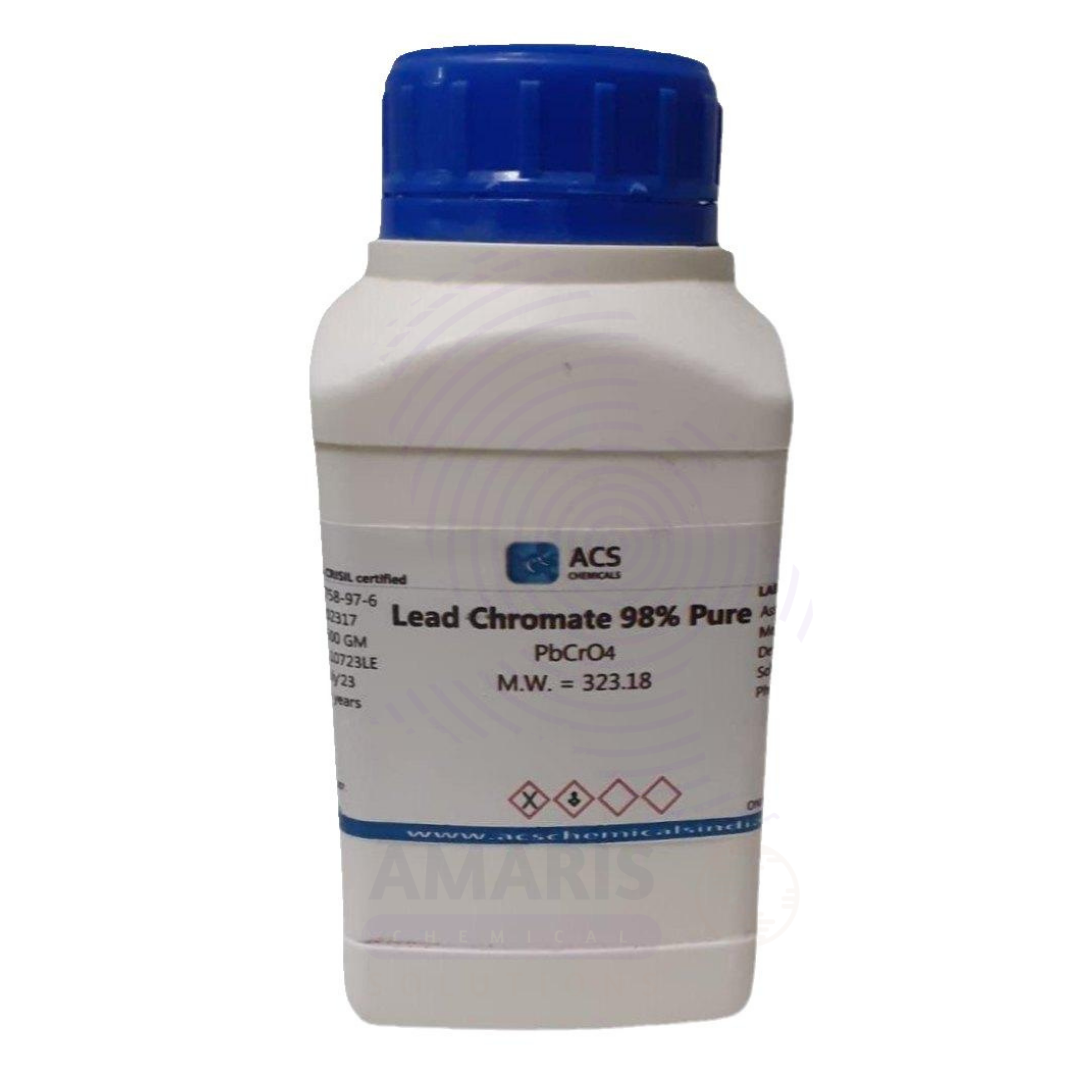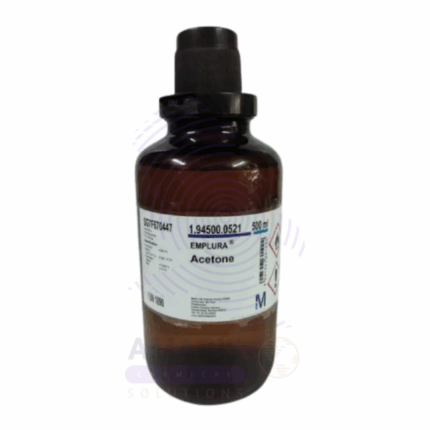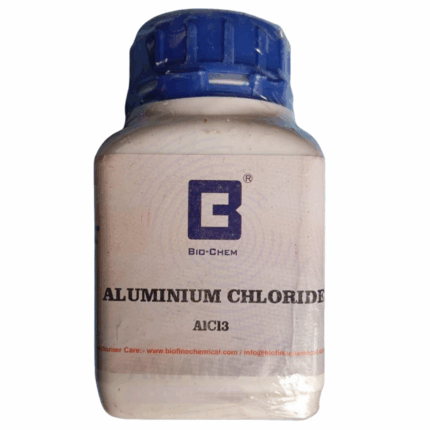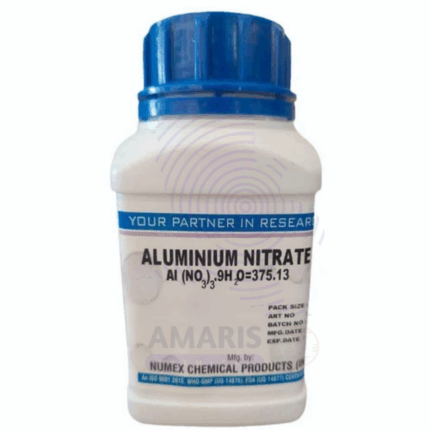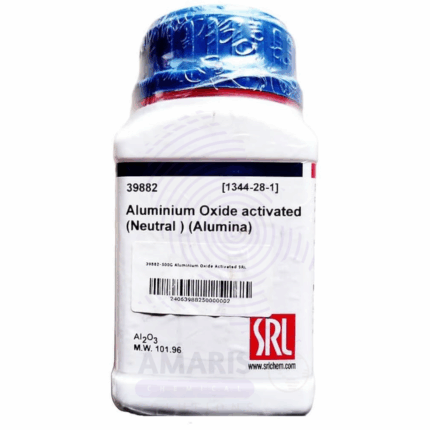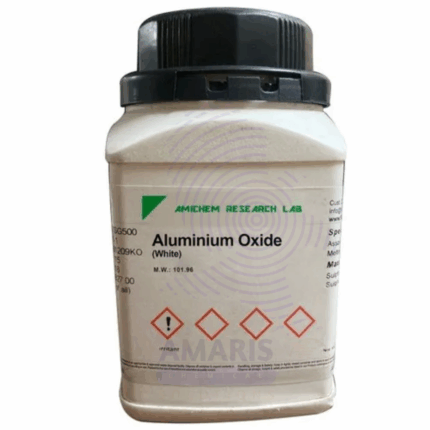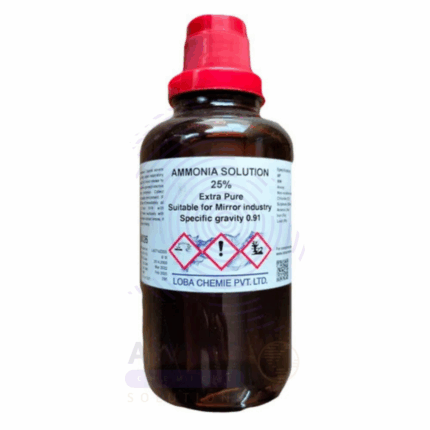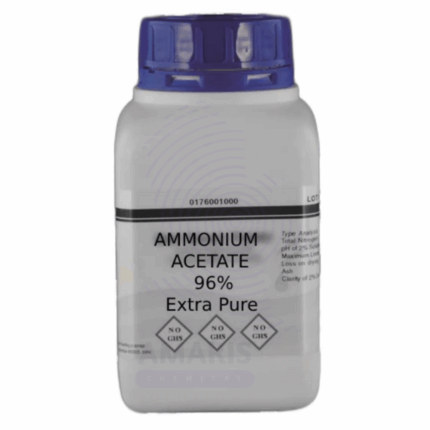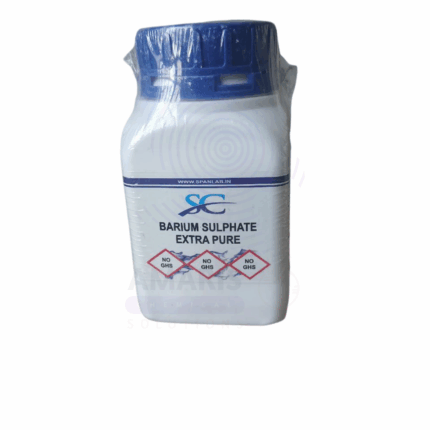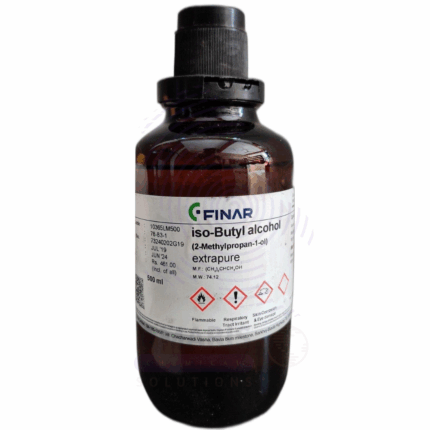
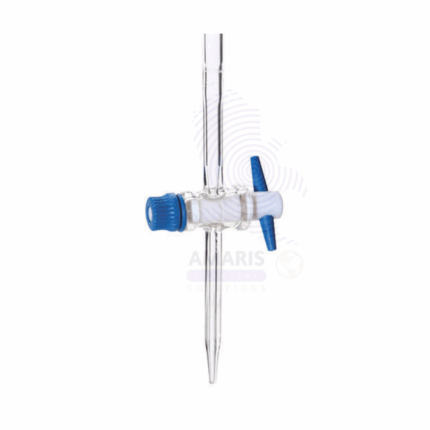
Lead Chromate Extra Pure
$ 23.10 Original price was: $ 23.10.$ 23.00Current price is: $ 23.00.
Lead Chromate Extra Pure is a bright yellow crystalline powder with the chemical formula PbCrO₄, known for its vivid pigmentation and high stability. This high-purity grade is commonly used in analytical laboratories, academic research, and historical pigment studies, particularly in the creation of reference standards and specialized reactions. It was historically used as a pigment (chrome yellow) in paints, plastics, and ceramics, although such applications have declined due to toxicity concerns. Lead chromate remains relevant in educational demonstrations, qualitative analysis, and scientific formulations where precise chemical behavior is required. Due to its carcinogenic and toxic nature, it must be handled with appropriate protective equipment and stored securely.
Lead Chromate Extra Pure
Primary Uses
- Pigment Study (Chrome Yellow):
Commonly used as a reference pigment in analytical chemistry and materials science to explore the properties of inorganic colorants. - Inorganic Precipitation Reactions:
Utilized to demonstrate double displacement reactions and low-solubility chromate salts in qualitative inorganic analysis.
Secondary Uses
- Toxicology & Environmental Testing:
Employed in controlled studies examining the toxicological behavior of heavy metal chromates. - Historical Paint Formulation Studies:
Studied in forensic chemistry and art conservation for identifying and recreating historical pigment compositions. - Crystallography and Structural Analysis:
Used in X-ray diffraction studies to analyze lattice parameters and structure of complex chromates.
| PACK SIZE |
250 grams Plastic Tin |
|---|
1. Basic Identification Attributes
- Chemical Name: Lead(II) Chromate
- Synonyms: Chrome yellow, C.I. Pigment Yellow 34
- Chemical Formula: PbCrO₄
- CAS Number: 7758-97-6
- Molecular Weight: 323.20 g/mol
- Grade: Extra Pure (suitable for laboratory and analytical use)
- Appearance: Bright yellow crystalline powder
- Odor: Odorless
- Solubility: Practically insoluble in water and alcohol; soluble in nitric acid and alkali cyanides
- Melting Point: Decomposes before melting
2. Safety & Hazard Attributes
- GHS Classification:
- Carcinogenicity – Category 1B
- Reproductive Toxicity – Category 1A
- Acute Toxicity – Inhalation (Category 4)
- Specific Target Organ Toxicity (Repeated Exposure) – Category 2
- Aquatic Toxicity – Chronic (Category 1)
- Hazard Statements:
- H302: Harmful if swallowed
- H350: May cause cancer
- H360: May damage fertility or the unborn child
- H373: May cause damage to organs through prolonged or repeated exposure
- H400: Very toxic to aquatic life
- H410: Very toxic to aquatic life with long-lasting effects
- Precautionary Statements:
- P201: Obtain special instructions before use
- P260: Do not breathe dust/fumes
- P273: Avoid release to the environment
- P281: Use personal protective equipment as required
- P308+P313: If exposed or concerned, seek medical advice
- Personal Protective Equipment (PPE):
- Gloves (chemical-resistant)
- Lab coat
- Safety goggles or full-face protection
- Dust mask or respirator in powder-handling
- Operate in a fume hood when possible
- First Aid Measures:
- Inhalation: Remove to fresh air; get immediate medical help
- Skin Contact: Rinse with water and soap
- Eye Contact: Rinse thoroughly with water for at least 15 minutes
- Ingestion: Rinse mouth; seek immediate medical attention
- Fire Hazards:
- Not flammable
- May emit toxic chromium and lead fumes when heated
- Use extinguishing media appropriate for surrounding fire
3. Storage & Handling Attributes
- Storage Conditions:
- Store in tightly sealed containers
- Keep in a dry, well-ventilated chemical storage area
- Store away from incompatible substances (acids, reducing agents)
- Limit access to trained personnel
- Handling Tips:
- Avoid generation of dust
- Do not eat, drink, or smoke while handling
- Handle under fume hood if powder is airborne
- Clean spills using wet methods or HEPA-filter vacuum
4. Laboratory Applications
- Primary Uses:
- Common pigment in academic demonstrations (chrome yellow)
- Used in analytical chemistry to demonstrate precipitation reactions
- Precursor for other lead/chromium compounds in synthesis
- Secondary Uses:
- Pigment reference in color chemistry and spectroscopy
- Teaching compound in discussions on toxicology, solubility, and carcinogens
- Demonstration of sparingly soluble salts in qualitative inorganic analysis
SAFETY PRECAUTIONS
Personal Protective Equipment (PPE):
- Wear a lab coat, chemical-resistant gloves (nitrile or neoprene), and safety goggles.
- Use a NIOSH-approved respirator if dust or fumes are present.
- Always handle in a fume hood or well-ventilated area.
Handling:
- Handle with extreme caution—carcinogenic, mutagenic, and toxic by inhalation, ingestion, and skin contact.
- Avoid generating or breathing dust.
- Do not eat, drink, or smoke while handling.
- Wash hands thoroughly after use.
Storage:
- Store in a tightly sealed container in a cool, dry, and well-ventilated area.
- Keep away from acids, reducing agents, and organic materials.
- Label clearly as Toxic and Carcinogenic and restrict access.
FIRST AID MEASURES
Inhalation:
- Move the exposed person to fresh air immediately.
- Seek immediate medical attention if symptoms like coughing, shortness of breath, or dizziness occur.
Skin Contact:
- Remove contaminated clothing immediately.
- Rinse skin thoroughly with soap and water for at least 15 minutes.
- Get medical advice if irritation develops.
Eye Contact:
- Flush your eyes cautiously with plenty of water for at least 15 minutes.
- Remove contact lenses if present and easy to do.
- Seek urgent medical attention.
Ingestion:
- Rinse mouth with water—do NOT induce vomiting.
- Seek immediate medical attention.
- Lead chromate is highly toxic and poses a severe health risk.
FIRE FIGHTING MEASURES
Flammability:
- Non-combustible, but may release toxic fumes when heated.
Extinguishing Media:
- Use dry chemicals, foam, or CO₂.
- Water spray can cool containers but avoid water runoff contamination.
Hazardous Combustion Products:
- May release toxic lead oxides and chromium oxides (Cr⁶⁺).
Firefighter Protection:
- Wear self-contained breathing apparatus (SCBA) and full protective clothing.
- Avoid inhaling combustion gases.


 Preservatives(food)
Preservatives(food) Flavor Enhancers
Flavor Enhancers Acidulants
Acidulants Sweeteners
Sweeteners Antioxidants
Antioxidants Colorants(food)
Colorants(food) Nutraceutical Ingredients (food)
Nutraceutical Ingredients (food) Nutrient Supplements
Nutrient Supplements Emulsifiers
Emulsifiers
 Collectors
Collectors Dust Suppressants
Dust Suppressants Explosives and Blasting Agents
Explosives and Blasting Agents Flocculants and Coagulants
Flocculants and Coagulants Frothers
Frothers Leaching Agents
Leaching Agents pH Modifiers
pH Modifiers Precious Metal Extraction Agents
Precious Metal Extraction Agents
 Antioxidants(plastic)
Antioxidants(plastic) Colorants (Pigments, Dyes)
Colorants (Pigments, Dyes) Fillers and Reinforcements
Fillers and Reinforcements Flame Retardants
Flame Retardants Monomers
Monomers Plasticizers
Plasticizers Polymerization Initiators
Polymerization Initiators Stabilizers (UV, Heat)
Stabilizers (UV, Heat)
 Antifoaming Agents
Antifoaming Agents Chelating Agents
Chelating Agents Coagulants and Flocculants
Coagulants and Flocculants Corrosion Inhibitors
Corrosion Inhibitors Disinfectants and Biocides
Disinfectants and Biocides Oxidizing Agents
Oxidizing Agents pH Adjusters
pH Adjusters Scale Inhibitors( water)
Scale Inhibitors( water)
 Antioxidants(cosmetic)
Antioxidants(cosmetic) Emollients
Emollients Fragrances and Essential Oils
Fragrances and Essential Oils Humectants
Humectants Preservatives
Preservatives Surfactants(cosmetic)
Surfactants(cosmetic) Thickeners
Thickeners UV Filters
UV Filters
 Fertilizers
Fertilizers Soil Conditioners
Soil Conditioners Plant Growth Regulators
Plant Growth Regulators Animal Feed Additives
Animal Feed Additives Biostimulants
Biostimulants Pesticides (Herbicides, Insecticides, Fungicides)
Pesticides (Herbicides, Insecticides, Fungicides)
 Active Pharmaceutical Ingredients (APIs)
Active Pharmaceutical Ingredients (APIs) Excipients
Excipients Solvents(pharmaceutical)
Solvents(pharmaceutical) Antibiotics
Antibiotics Antiseptics and Disinfectants
Antiseptics and Disinfectants Vaccine Adjuvants
Vaccine Adjuvants Nutraceutical Ingredients (pharmaceutical)
Nutraceutical Ingredients (pharmaceutical) Analgesics & Antipyretics
Analgesics & Antipyretics
 Analytical Reagents
Analytical Reagents Solvents(lab)
Solvents(lab) Chromatography Chemicals
Chromatography Chemicals Spectroscopy Reagents
Spectroscopy Reagents microbiology-and-cell-culture-reagents
microbiology-and-cell-culture-reagents Molecular Biology Reagents
Molecular Biology Reagents Biochemical Reagents
Biochemical Reagents Inorganic and Organic Standards
Inorganic and Organic Standards Laboratory Safety Chemicals
Laboratory Safety Chemicals Specialty Laboratory Chemicals(Special Laboratory Equipment)
Specialty Laboratory Chemicals(Special Laboratory Equipment)
 Demulsifiers
Demulsifiers Hydraulic Fracturing Fluids
Hydraulic Fracturing Fluids Scale Inhibitors(oil)
Scale Inhibitors(oil) Surfactants(oil)
Surfactants(oil) Drilling Fluids
Drilling Fluids
 Dyes and Pigments
Dyes and Pigments Bleaching Agents
Bleaching Agents Softening Agents
Softening Agents Finishing Agents
Finishing Agents Antistatic Agents
Antistatic Agents
 Admixtures
Admixtures Waterproofing Agents
Waterproofing Agents Sealants and Adhesives
Sealants and Adhesives Curing Compounds
Curing Compounds Concrete Repair Chemicals
Concrete Repair Chemicals Anti-Corrosion Coatings
Anti-Corrosion Coatings
 Surfactants(cleaning)
Surfactants(cleaning) Builders
Builders Enzymes
Enzymes Solvents (Cleaning)
Solvents (Cleaning) Fragrances
Fragrances
 Electronic Chemicals
Electronic Chemicals Catalysts
Catalysts Lubricants
Lubricants Photographic Chemicals
Photographic Chemicals Refrigerants
Refrigerants Automotive chemicals
Automotive chemicals Pyrotechnic Chemicals
Pyrotechnic Chemicals
 Biodegradable Surfactants
Biodegradable Surfactants Bio-based Solvents
Bio-based Solvents Renewable Polymers
Renewable Polymers Carbon Capture Chemicals
Carbon Capture Chemicals Wastewater Treatment Chemicals
Wastewater Treatment Chemicals
 Pigments
Pigments Solvents(paint)
Solvents(paint) Specialty Coatings
Specialty Coatings Binders/Resins
Binders/Resins Additives
Additives Driers
Driers Anti-Corrosion Agents
Anti-Corrosion Agents Functional Coatings
Functional Coatings Application-Specific Coatings
Application-Specific Coatings
 Fresh Herbs
Fresh Herbs Ground Spices
Ground Spices Whole Spices
Whole Spices Spice Blends
Spice Blends Dried Herbs
Dried Herbs
 Leavening Agents
Leavening Agents Dough Conditioners
Dough Conditioners Flour Treatments
Flour Treatments Fat Replacers
Fat Replacers Decoratives
Decoratives Preservatives(baking)
Preservatives(baking)
 Plasticizers & Softeners
Plasticizers & Softeners Reinforcing Agents
Reinforcing Agents Adhesion Promoters
Adhesion Promoters Vulcanizing Agents
Vulcanizing Agents Antidegradants
Antidegradants Blowing Agents
Blowing Agents Fillers & Extenders
Fillers & Extenders Accelerators & Retarders
Accelerators & Retarders